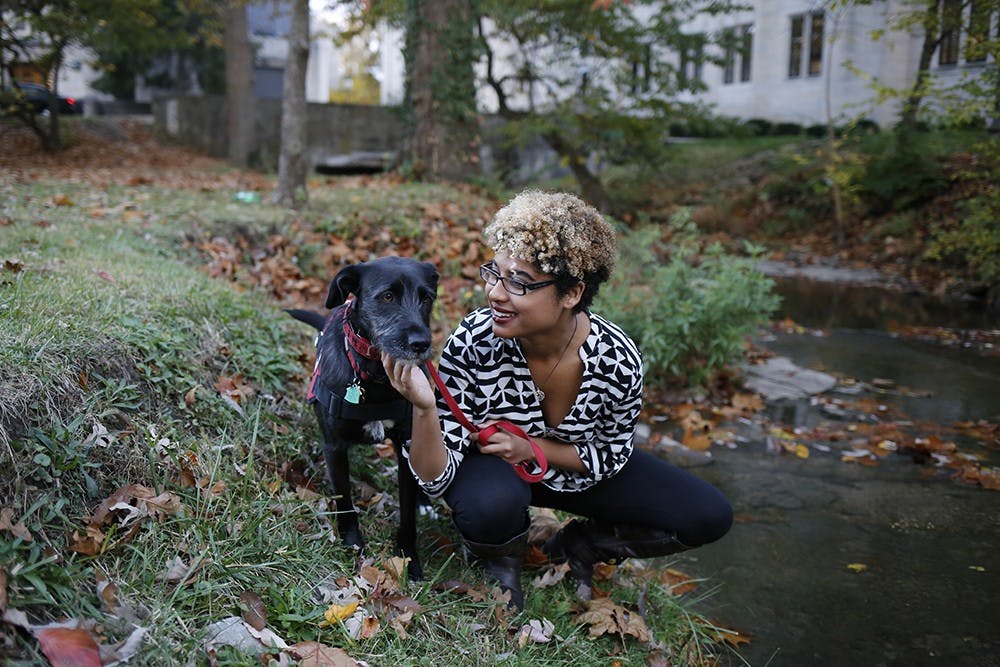When Kyla Jackson opened her eyes, she knew she was dying. Her throat was constricted as though something was jammed halfway down. Black dots sprinkled her vision, and the world seemed to whirl around her as she slipped toward unconsciousness.
When her mother came into her room, she grabbed Jackson’s diabetic finger-stick test and pricked her finger to test her blood sugar level. The normal level is 100. Hers was 13. Zero means death.
She drank a glass of carb-rich grape juice and waited. An hour later, she said she felt stable enough to go back to sleep.
No symptoms bothered the high school sophomore the next day, but a sense of fear had begun to form that would stay with her for years.
“It was pretty scary, especially when there is a zero that you can reach,” Jackson said. “When there’s nowhere else to go besides that zero.”
***
Three years later, Jackson walked into Starbucks on campus, a leash wrapped around her hand. Two-year-old mutt Caper barely reached her knees standing in line. Caper’s dark black and gray beard brushed against the IU freshman’s leg while she ordered a grande mocha Frappuccino.
The pup was alert, scanning the room until Jackson stroked her head. Understanding the area was safe, the certified service dog sat down. It is Caper’s job to monitor Jackson’s diabetes at all times of the day.
With diabetes rapidly tripling — from 5.6 million diagnoses in 1980 to 20.9 million in 2011, according to the Centers for Disease Control and Prevention website — a need for extra assistance with regulation is necessary. Though dogs were trained to assist the visually impaired in the 1930s, diabetic-alert dog training programs only emerged in the past few years.
Jackson found Caper through a program called Heads Up Hounds. Operating since July 2013, this program has already trained and matched 47 rescue dogs with people to help them manage their Type 1 diabetes. Having this type means Jackson’s body is unable to produce the hormone insulin that allows her body to turn glucose into energy. She uses synthetic insulin through a pump but needs Caper to alert her when the level of insulin gets too high or too low.
Although Jackson said she has only been with Caper for nearly four months, the dog’s help on a daily basis is giving her the confidence and freedom to fully appreciate college life.
During the spring of Jackson’s junior year in high school, she knew she needed extra help with her diabetes. A family member told Jackson of a girl in Bloomington with a diabetic service dog from Heads Up Hounds. Jackson and her mother contacted the Nebraska-based company, and within a year they were on their way to meet Caper and trainer Joe Cook.
Just before noon on July 18, Jackson leaned into an oversized hotel chair and fanned the tears away from her eyes as she prepared to meet her new dog.
“Hi,” she said in a high-pitched voice.
Across the room, Cook poured creamer into his coffee as Caper lay at his feet.
“I’m trying really hard not to cry now,” Jackson said, looking away from the pup in a red work vest. “So I’m going to look over here.”
“Yeah, you’ll make it for about the first four hours,” Cook said. “And then when I hand you the leash it will be all over.”
Cook finished stirring his drink and brought Caper over to join Jackson and her mom.
Minutes later, Caper started bumping Cook’s hand as he was explaining how a service dog would change Jackson’s life. Caper’s bumping grew more persistent. Finally, Cook told Jackson she should check her blood sugar.
Cook used samples of Jackson’s blood sugar level to train Caper to detect when her level gets too high or too low. When her level changes, her body releases chemicals that emit a distinct odor that only dogs can detect, according to the Diabetic Alert Dogs of America website. That was what Caper was telling Cook when she was in the room with Jackson for the first time.
“We hadn’t officially met, she hadn’t acknowledged me yet, and she still alerted,” Jackson said. “I just got this glimpse of it. This glimpse of this security and peace and protection. It was amazing.”
***
Diagnosed at four years old, Jackson said growing up with diabetes was never easy. Before the insulin pump was available, Jackson and her parents had to watch her every move to ensure her blood sugar level wouldn’t get out of control. She counted carbs at every meal, and pricked her finger up to five times a day to check her levels. Over time, tiny bumps covered the tops of her fingers. If her levels were abnormal she wasn’t allowed to go out and play with her friends.
Jackson said her mom told her she grew up really fast because she had to.
“A lot of kids think they’re invincible,” Jackson said. “I never thought I was because I always knew how fragile it all could be. It’s constant vigilance and responsibility even so young.”
Jackson wasn’t the only one with hefty responsibilities and stress. Donna Martin, Jackson’s mother, said she distinctly remembers the time she and her family stopped at an ice cream shop on vacation. The rest of the family wandered off and left Martin to juggle two ice cream cones while putting Jackson into her booster seat. When she tried to check her daughter’s blood sugar level, the 5-year-old’s Zanzibar chocolate ice cream splattered onto the sidewalk.
Martin immediately started to cry.
“The incident wasn’t a big deal in and of itself, but I think that was the first moment as a parent that I realized that this was forever,” Martin said. “Here we were on vacation letting go of the cares of regular life and diabetes is still there.”
***
The fear Jackson said she felt on her bedroom floor three years ago is gone.
Kyla said each moment she spends with Caper reminds her how lucky she feels to have the immense support now.
“With Caper I’m outgoing, living on campus, sociable, have friends and I have a life,” Jackson said. “I don’t know how to describe it, but it’s the look she gives me sometimes that she knows and understands how much I love her. It’s not like she’s a pet — it’s like she’s a friend.”
Eating her dinner in a booth at a dining hall on campus, Jackson calculated in her head the amount of carbs in the pasta, broccoli and milk. Moments later, Caper jumped onto the seat next to her and inched toward Jackson’s mouth. Caper uses Jackson’s breath to detect her blood sugar level. Jackson describes the smell of her breath to Caper as “a fire hose exploding with this scent.”
She immediately checked her insulin pump, noticed her blood sugar level was high and made the needed adjustments.
“Thank you, good girl,” Jackson said. “Thank you. Good dog.”






